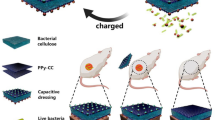Abstract
The effect of the activity of immobilized enzymes on the initial attachment of pathogenic bacteria commonly associated with nosocomial infections (Pseudomonas aeruginosa and Staphylococcus epidermidis) was investigated. The proteolytic enzymes, subtilisin A and the glycoside hydrolase cellulose, were covalently attached onto poly(ethylene-alt-maleic) anhydride copolymer films. A comparison between active and heat-inactivated surfaces showed that while the activity of immobilized cellulase reduced the attachment of S. epidermidis by 67%, it had no effect on the attachment of P. aeruginosa. Immobilized subtilisin A had opposite effects: the active enzyme had no effect on the attachment of S. epidermidis but reduced the attachment of P. aeruginosa by 44%. The results suggest that different biomolecules are involved in the initial steps of attachment of different bacteria, and that the development of broad-spectrum antifouling enzymatic coatings will need to involve the co-immobilization of enzymes.





Similar content being viewed by others
References
Anderson KW, Loiselle M, Bachas L (2003) Use of enzymes to inhibit biofouling. Proceedings 26th annual meeting of the adhesion society:pp 451–453
Augustin M, Ali-Vehmas T, Atroshi F (2004) Assessment of enzymatic cleaning agents and disinfectants against bacterial biofilms. J Pharm Pharm Sci 7(1):55–64
Beldman G, Leeuwen MF, Rombouts FM, Voragen FGJ (1985) The cellulase of Trichoderma viride. Eur J Biochem 146:301–308
Chaignon P, Sadovskaya I, Ragunah C, Ramasubbu N, Kaplan JB, Jabbouri S (2007) Susceptibility of staphylococcal biofilms to enzymatic treatments depends on their chemical composition. Appl Microbiol Biotechnol 75(1):125–132
Cordeiro AL, Werner C (2011) Enzymes for antifouling strategies. J Adhes Sci Technol
Cordeiro AL, Pompe T, Salchert K, Werner C (2011) Enzyme immobilization on reactive polymer films. In: Mark SS (ed) Methods in molecular biology: bioconjugation protocols. Springer, New York
Dobretsov S, Dahms H-U, Qian P-Y (2006) Inhibition of biofouling by marine microorganisms and their metabolites. Biofouling 22:43–54
Fischer M, Sperling C, Tengvall P, Werner C (2010) The ability of surface characteristics of materials to trigger leukocyte tissue factor expression. Biomaterials 31:2498–2507
Ghose TK (1987) Measurement of cellulase activities. Pure Appl Chem 59(2):257–268
Hangler M, Burnolle M, Schneider J, Allermann K, Jensen B (2009) The serine protease Esperase HPF inhibits the formation of multispecies biofilm. Biofouling 25:667–674
Kaplan JB (2009) Therapeutic potential of biofilm-dispersing enzymes. Int J Artif Organs 32(9):545–554
Kristensen JB, Meyer RL, Laursen BS, Shipovskov S, Besenbacher F, Poulsen CH (2008) Antifouling enzymes and the biochemistry of marine settlement. Biotechnol Adv 26:471–481
Lequette Y, Boels G, Clarisse M, Faille C (2010) Using enzymes to remove biofilms of bacterial isolates sampled in the food-industry. Biofouling 26(4):421–431
Leroy C, Delbarre C, Ghillebaert F, Compere C, Combes D (2008a) Effects of commercial enzymes on the adhesion of a marine biofilm-forming bacterium. Biofouling 24:11–22
Leroy C, Delbarre C, Ghillebaert F, Compere C, Combes D (2008b) Influence of subtilisin on the adhesion of a marine bacterium which produces mainly proteins as extracellular polymers. J Appl Microbiol 105:791–799
Loiselle M, Anderson KW (2003) The use of cellulase in inhibiting biofilm formation from organisms commonly found on medical implants. Biofouling 19(2):77–85
Olsen SM, Pedersen LT, Laursen MH, Kiil S, Dam-Johansen K (2007) Enzyme-based antifouling coatings: a review. Biofouling 23(5):369–383
Osaki T, Werner C (2003) Ionization characteristics and structural transitions of alternating maleic acid copolymer films. Langmuir 19:5787–5793
Pettitt ME, Henry SL, Callow ME, Callow JA, Clare AS (2004) Activity of commercial enzymes on settlement and adhesion of cypris larvae of the barnacle Balanus amphitrite, spores of the green alga Ulva linza, and the diatom Navicula perminuta. Biofouling 20:299–311
Pompe T, Zschoche S, Herold N, Salchert K, Gouzy MF, Sperling C, Werner C (2003) Maleic anhydride copolymers-A versatile platform for molecular biosurface engineering. Biomacromolecules 4:1072–1079
Pompe T, Renner L, Grimmer M, Herold N, Werner C (2005) Functional films of maleic anhydride copolymers under physiological conditions. Macromol Biosci 5:890–895
Tasso M, Cordeiro AL, Salchert K, Werner C (2009a) Covalent immobilization of subtilisin A onto thin films of maleic anhydride copolymers. Macromol Biosci 9:922–929
Tasso M, Pettitt ME, Cordeiro AL, Callow ME, Callow JA, Werner C (2009b) Antifouling potential of Subtilisin A immobilized onto maleic anhydride copolymer thin films. Biofouling 25:505–516
Acknowledgments
The authors are grateful to Tina Lenk and Nelly Rein (Leibniz Institute of Polymer Research Dresden, Germany), and to Irina Elert (BASF SE, Ludwigshafen, Germany) for technical support.
Author information
Authors and Affiliations
Corresponding author
Rights and permissions
About this article
Cite this article
Cordeiro, A.L., Hippius, C. & Werner, C. Immobilized enzymes affect biofilm formation. Biotechnol Lett 33, 1897–1904 (2011). https://doi.org/10.1007/s10529-011-0643-3
Received:
Accepted:
Published:
Issue Date:
DOI: https://doi.org/10.1007/s10529-011-0643-3




